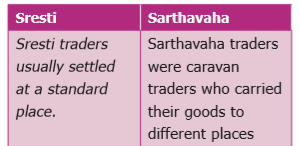The Age of Empires: Guptas Notes 6th Social Science
The Age of Empires: Guptas Notes 6th Social Science
6th Social Science Lesson 17 Notes in English
17. The Age of Empires: Guptas
1. How does the Gupta Dynasty Emerged?
After the decline of Kushanas and Satavahanas, Chandragupta carved out a kingdom and establish his dynastic rule, which lasted for about two hundred years.
2. Archaeological Sources
- Gold, silver and copper coins issued by Gupta rulers.
- Allahabad Pillar Inscription of Samudragupta.
- The Mehrauli Iron Pillar Inscription.
- Udayagiri Cave Inscription, Mathura Stone Inscription and Sanchi Stone Inscription of Chandragupta II.
- Bhitari Pillar Inscription of Skandagupta.
- The Gadhwa Stone Inscription.
- Madubhan Copper Plate Inscription
- Sonpat Copper Plate
- Nalanda Inscription on clay seal
3. Literary Sources
- Vishnu, Matsya, Vayu and Bhagavata
- Puranas and Niti Sastras of Narada
- Visakhadatta’s Devichandraguptam and Mudrarakshasa and Bana’s Harshacharita Dramas of Kalidasa
- Accounts of Chinese Buddhist monk Fahien who visited India during the reign of Chandragupta II.
4. Who was the Founder of Gupta dynasty?
Sri Gupta is considered to be the founder of the Gupta dynasty. He is believed to have reigned over parts of present-day Bengal and Bihar. He was the first Gupta ruler to be featured on coins.
6th Social Book Back Questions
5. Who were Maharajas?
Sri Gupta was succeeded by his son Ghatotkacha. Both are mentioned as Maharajas in inscriptions.
6. Chandragupta I (c. 319–335 AD (CE))
Chandragupta I married Kumaradevi of the famous and powerful Lichchhavi family. Having gained the support of this family, Chandragupta could eliminate various small states in northern India and crown himself the monarch of a larger kingdom.
7. What were the Gold coins consists of?
The gold coins attributed to Chandragupta bear the images of Chandragupta, Kumaradevi and the legend ‘Lichchhavayah’.
8. Samudragupta (c. 335–380)
Samudragupta, son of Chandragupta I, was the greatest ruler of the dynasty. Consolidation of Gupta Dynasty Samudragupta was a great general and when he became emperor, he carried on a vigorous campaign all over the country and even in the south.
9. Explain Allahabad Pillar Inscriptions:
The Prayog Prashasti, composed by Samudragupta’s court poet Harisena was engraved on Allahabad Pillar. This Allahabad Pillar inscription is the main source of information for Samudragupta’s reign.
10. Various Places Conquered by Samudragupta:
- In the southern Pallava kingdom, the king who was defeated by Samudragupta was Vishnugopa.
- Samudragupta conquered nine kingdoms in northern India.
- He reduced 12 rulers of the southern India to the status of feudatories and forced them to pay tribute.
- He received homage from the rulers of East Bengal, Assam, Nepal, the eastern part of Punjab and various tribes of Rajasthan.
11. Chandragupta II (c.380 – 415)
Chandragupta II was the son of Samudragupta. He was also known as Vikramaditya.
12. Various Achievements of Chandragupta II:
He conquered western Malwa and Gujarat by defeating the Saka rulers. He maintained friendly relationship with the rulers of southern India.
13. Who built the Nalanda University?
The iron pillar near Chandragupta II was succeeded by his son Kumaragupta I, who built the famous Nalanda University.
14. Who defeated the Huns?
Kumaragupta’s successor Skandagupta had to face a new threat in the form of the invasion of Huns. He defeated them and drove them away. But after twelve years, they came again and broke the back of the Gupta Empire.
15. Who was the last of Great Guptas?
The last of the great Guptas was Baladitya, assumed to have been Narasimha Gupta I. He was himself attracted towards Buddhism.
16. Who drove away Baladitya?
Mihirakula turned treacherous and drove away Baladitya from Magadha. After Baladitya, the great Gupta Empire faded away.
17. Who was the last recognised king of Gupta Empire?
The last recognised king of the Gupta Empire was Vishnugupta.
18. Explain Gupta Polity:
The divine theory of kingship (the concept that king is the representative of God on earth and so he is answerable only to God and not to anyone else) was practised by the Gupta rulers. The Gupta kings wielded enormous power in political, administrative, military and judicial spheres.
19. How the Kings were assisted?
The Gupta king was assisted by a council of mantris (ministers). The council consisted of princes, high officials and feudatories. A large number of officials were employed by the Gupta rulers to carry on the day-to-day administration of the country.
20. Rankings of Gupta Empire:
- High-ranking officials were called dandanayakas and mahadandanayakas.
- The Gupta Empire was divided into provinces known as deshas or bhuktis .
- They were administered by the governors, designated as uparikas .
- The province was divided into districts such as vishyas and they were controlled by the officers known as vishyapatis .
- At the village level, there were functionaries such as gramika and gramadhyaksha .
21. What are Millitary organisation of Guptas?
The extensive empire shows the important role of military organisation. Seals and inscriptions mentioned military designations as baladhikrita and mahabaladhikrita (commander of infantry and cavalry respectively). The system of espionage included spies known as dutakas .
22. Society and Economy:
Land and Peasants Nitisara , authored by Kamandaka, emphasises the importance of the royal treasury and mentions various sources of revenue. The military campaigns of kings like Samudragupta were financed through revenue surpluses.
23. Taxation in Gupta Empire:
Land tax was the main revenue to the government. The condition of peasants was pathetic. They were required to pay various taxes. They were reduced to the position of serfs.
24. Trade and Commerce :
The contribution of the traders for the development of Gupta’s economy was very impressive. There were two types of traders, namely Sresti and Sarthavaha.
25. What were the Important Trade goods?
Trade items ranged from daily products to valuable and luxury goods. The important trade goods were pepper,gold, copper, iron, horses and elephants.
26. Transport System of Guptas:
The Guptas developed roadways connecting different parts of the country. Pataliputra, Ujjain, Benaras, Mathura were the famous trade centres. Ports in western (Kalyan, Mangalore, Malabar) and eastern (Tamralipti in Bengal) coasts of India facilitated trade.
27. Explain Metallurgy:
Mining and metallurgy were the most flourishing industries during the Gupta period. The most important evidence of development in metallurgy was the Mehrauli Iron Pillar installed by King Chandragupta in Delhi. This monolithic iron pillar has lasted through the centuries without rusting.
28: Define Society:
The society that adhered to four varna system was patriarchal. According to laws of Manu, which was in force, women should be under the protection of their father, husband or eldest son.
29. What were the bad evils of Society?
Polygamy was widely prevalent. The kings and feudatory lords often had more than one wife. Inscriptions refer to Kubernaga and Dhrubaswamini as the queens of Chandragupta II. Sati was practised during the Gupta rule.
30. Explain Slavery System:
Slavery was not institutionalised in India, as in the West. But there are references to the existence of various categories of slaves during the Gupta age.
31. Religion Practise of Guptas:
There was revival of Vedic religion and Vedic rites. Samudragupta and Kumaragupta I performed Asvamedha Yagna (a horse sacrifice ritual).
32. What were two sects emerged during Guptas?
We notice the beginning of image worship and the emergence of two sects, namely Vaishnavism and Saivism, during the Gupta period. Buddhism also continued to flourish though it split into two sects, namely Hinayana and Mahayana.
33. Art and Architecture of Guptas:
The Guptas were the first to construct temples, which evolved from the earlier tradition of rock-cut shrines. Adorned with towers and elaborate carvings, these temples were dedicated to all Hindu deities.
34. Illustrate important Architecture of Guptas:
- The most notable rock-cut caves are found at Ajanta and Ellora (Maharashtra), Bagh (Madhya Pradesh) and Udaygiri (Odisha).
- The structural temples built during this period resemble the characteristic features of the Dravidian style.
- Two remarkable examples of Gupta metal sculpture are
(i) a copper image of Buddha about 18 feet high at Nalanda and
(ii) Sultanganj Buddha seven-and-a half feet in height.
- The most important examples of the Gupta paintings are found on the Fresco of the Ajanta caves and the Bagh cave in Gwalior.
35. What was the official Language of Guptas?
Though the language spoken by the people was Prakrit, the Guptas made Sanskrit the official language and all their epigraphic records are in Sanskrit.
36. Show the Growth of Sanskrit:
The Gupta period also saw the development of Sanskrit grammar based on the grammar of Panini and Patanjali who wrote Ashtadhyayi and Mahabhashya respectively.
37. Who composed chandravyakaranam?
A Buddhist scholar from Bengal, Chandrogomia, composed a book on grammar titled Chandravyakaranam .
38. Show the Various work of Kalidasa:
Kalidasa’s famous dramas were Sakunthala , Malavikagnimitra and Vikramaoorvashiyam. Other significant works of Kalidasa were Meghaduta , Raghuvamsa, Kumarasambava and Ritusamhara.
39. What made Guptas legacy to modern world?
Invention of zero and the consequent evolution of the decimal system were the legacy of Guptas to the modern world.
40. Name the famous Astronomers:
Aryabhatta, Varahamihira and Brahmagupta were foremost astronomers and mathematicians of the time.
41. Who was the first to say earth revolve on its axis?
Aryabhatta, in his book Surya Siddhanta, explained the true causes of solar and lunar eclipses. He was the first Indian astronomer to declare that the earth revolves around its own axis.
42. Name various experts in Various fields:
- Dhanvantri was a famous scholar in the field of medicine. He was a specialist in Ayurveda.
- Charaka was a medical scientist.
- Susruta was the first Indian to explain the process of surgery.
43. The metals used by them were: iron, gold, copper, tin, lead, brass, bronze, bell- metal, mica, manganese and red chalk.
44. Samudragupta introduced the Gupta monetary system. Kushana coins provided inspiration to Samudragupta. The Gupta gold coins were known as Dinara .
45. Write a note on Fahien:
During the reign of Chandragupta II, the Buddhist monk Fahien visited India. His travel accounts provided us information about the socio-economic, religious and moral conditions of the people of the Gupta age.
46. According to Fahien, the people of Magadha were happy and prosperous, that justice was mildly administered and there was no death penalty. Gaya was desolated. Kapilavasthu had become a jungle, but at Pataliputra people were rich and prosperous.
47. Srimeghavarman, the Buddhist king of Ceylon, was a contemporary of Samudragupta.
48. The surnames of Chandragupta II were Vikramaditya, Narendrachandra, Simhachandra, Narendrasimha, Vikrama Devaraja, Devagupta and Devasri.
49.Importance of samudragupta:
- Samudragupta was a devotee of Vishnu.
- He revived the Vedic practice of performing horse sacrifice to commemorate victories in wars. He issued gold coins and in one of them, he is portrayed playing harp (veenai).
- Samudragupta was not only a great conqueror but a lover of poetry and music and for this, he earned the title ‘Kaviraja’.
50. What is Prashasti?
Prashasti is a Sanskrit word, meaning commendation or ‘in praise of’. Court poets flattered their kings listing out their achievements. These accounts were later engraved on pillars so that the people could read them.
51. Lichchhavi was an old gana–sanga and its territory lay between the Ganges and the Nepal Terai.
52. Show the Navaratna in the Court of Vikramaditya:
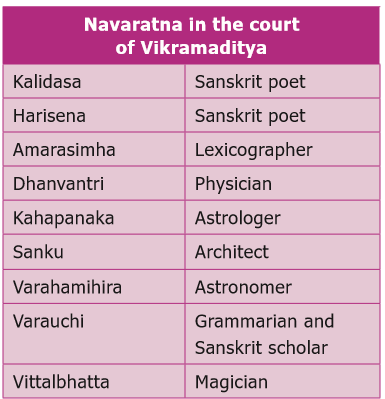
53. Show the Empire extent of Guptas:
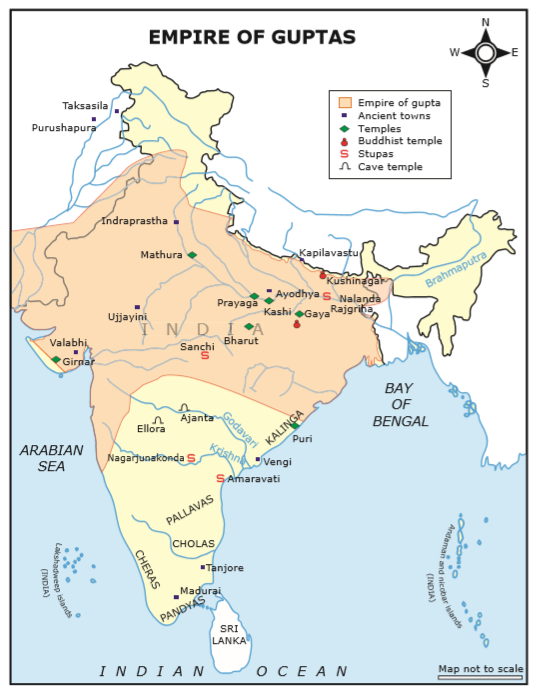
54. Classification of Land in Gupta Period:
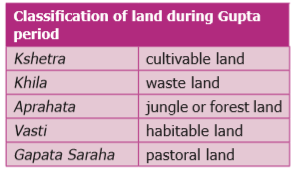
55. Show the Importance of Nalanda University:
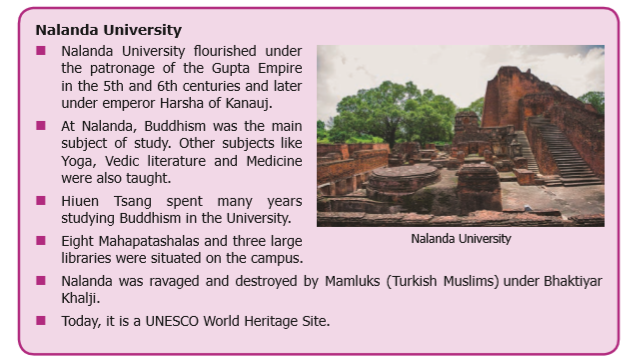
56. Who were Huns?
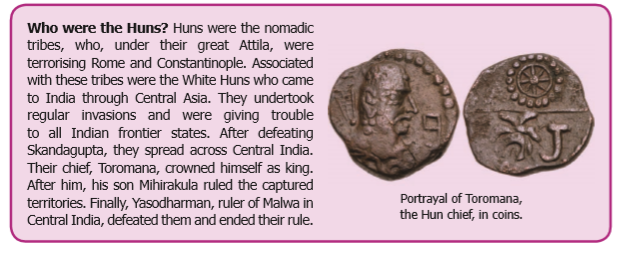
57. Show the Difference Between Sresti and Sarthavaha:
